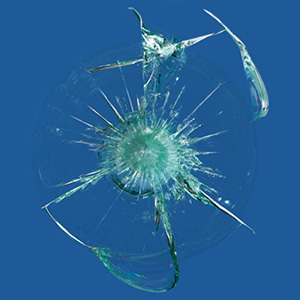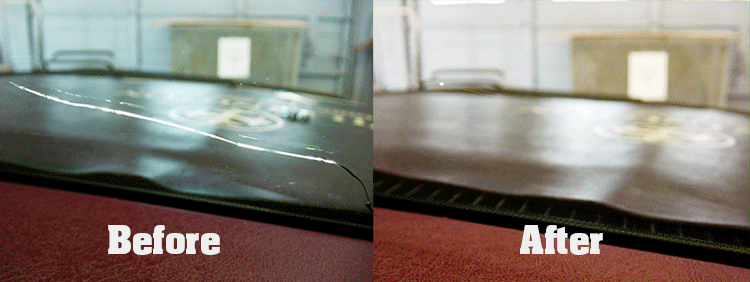What’s the Difference Between a Chip and a Crack in a Windshield?

A typical windshield chip. This one is considered to be a “combination break”.
Minor windshield damage normally comes in two major forms – chips and cracks. A chip is generally damage in the windshield that clearly marks the point of impact by debris. This point of impact can be in the form of a star break (short cracks forming outward from the center), bulls-eye (circular), partial bulls-eye (half-moon shape), crack chip (small crack less than _ inch), or pit (gouge). Cracks create a distinct line in the glass that can range from under an inch up to the width of your windshield. They generally run horizontally in a straight or somewhat wavy line.
Even long cracks in a windshield are sometimes repairable.
Can Your Glass be Repaired?
Whether or not your windshield can be repaired depends on three main factors: size, depth, and location. Larger, deeper cracks in the glass that extend to the edges of your windshield are much more likely to need replacement than small shallow chips away from the edges of your windshield.
Below, we’ll look more into these three deciding factors:
Size
Windshield repair technology is a rapidly advancing industry, so the ability to repair large chips or cracks changes often and can vary depending on the repair company. Generally speaking, chips smaller than a quarter, and cracks up to three inches long can be easily repaired. The Repair of Laminated Automotive Glass Standard (ROLAGS) guide, administered by the National Windshield Repair Association (NWRA), specifies limits on repair sizes depending on the type of damage (bulls-eye, pit, crack, ect.) with the upper limits of a chip being three inches and a crack up to 14 inches. Again, these sizes may vary depending on the location of the damage, as well as the shop’s capabilities. For more technical specifications, check out the full ROLAGS guide the full ROLAGS guide.

Depth
This is closely related to the size of the damage, but in regards to how deep the damage penetrates into the windshield. A windshield is basically a glass sandwich– an outer layer of glass, a plastic interlayer, and an inside layer of glass. If the damage is through the outer and inner layer of glass, it is too deep to perform a windshield repair.
Location
The location of the damage greatly effects the ability to perform a windshield repair. If the damage extends to the outer edge of the glass, there is a greater chance that the structural integrity of the windshield has been compromised. Because the windshield is responsible for up to 60% of structural strength in the event of vehicle rollover, it is imperative that it is replaced properly with a new windshield.
Another place where windshield repair should not be performed is within the driver’s line of sight (the glass covered by the driver’s windshield wiper). Repairs will often cause some amount of distortion which can impair a driver’s view of the road if within their line of sight.
Lastly, damage in the view of sensors such as rain sensors, lane departure warning systems, automatic braking systems, or other automated driver assistance systems (ADAS) related components may not be repairable. These sensors require a crystal clear view and even a near perfect repair may cause malfunctions.
When to Replace Your Auto Glass
Safety
Above all, safety is paramount. Many consumers think it’s okay to drive around with a crack in their windshield. It’s not—in fact this can pose a safety risk.
Call our support staff at 901-795-1078 for a free estimate or inspection.



